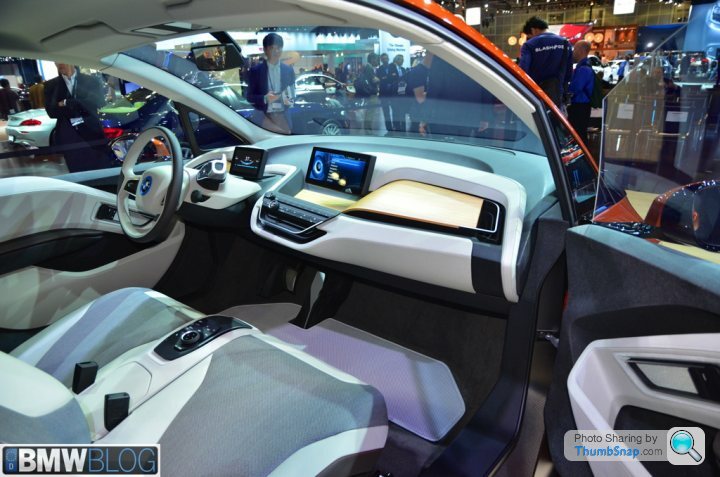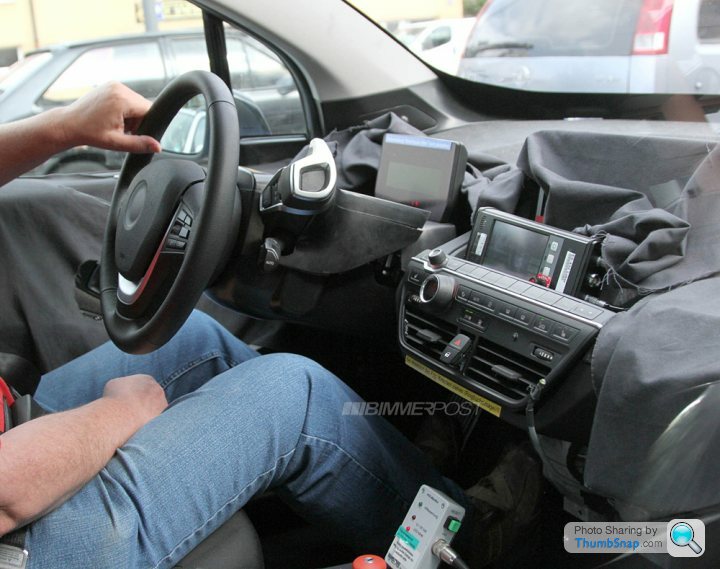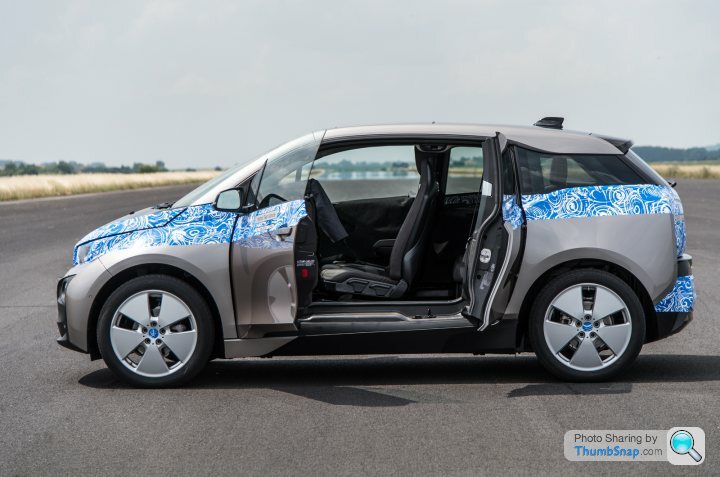2014 BMW i3 Prototype | Review
Harris gets an early go with BMW's pioneering carbon fibre city car

It will need to excel over short distances, consume minimal resources and be both comfortable and safe. It will also need to appear irresistible to the metro elite, seat four adults in comfort and debunk the myth that electric cars either don't work in the real world, or offer about as much showroom appeal as ... a Nissan Leaf.
In fact the last thing the i3 actually needs to do is to drive like a BMW, assuming that means smoke its rear tyres and engage reverse gear with a long-arm to the left. What it has to do is prove that BMW's take on electric transportation is, much like its gasoline-powered equivalent, rather better than other offerings.

It was the carbon fibre that did it for me. If the i3 was just a lump of steel festooned with posh Duracells I would have stayed at home and done some oversteer, but ever since McLaren launched the MP4/1 in 1981 we have been promised that this remarkable material would eventually be used to make ordinary cars. It has taken 32 years to reach that point. Sitting in a military hangar at BMW's Maisach driver training site near Munich, the i3's bare CFRP body structure looks to me like a decent approximation of the future. This isn't quite the full carbon machine we've been waiting for - the powertrain sits on an aluminium rolling chassis containing some gorgeously complicated castings. But the whole thing is beautifully engineered.
It is now rather late as I write this, so in the interests of my sanity, I'm going to post the full technical document released by BMW yesterday, comment on the aspects that caught my eye under the skin and tell you what it's like to drive on the smoothest section of asphalt in northern Europe. For 10 minutes.
The DIN unladen weight of the i3 is 1,195kg. You can view this either as a triumph in the knowledge that a Nissan Leaf is 1,520kg, or a shame that something so physically small should need to breach a ton. The batteries sit under the floor, the motor is at the rear, as is the range-extending two-cylinder motor, should you opt for it. This engine is not connected to the drivetrain, it is merely used to provide energy for the batteries.

Weight distribution is a perfect 50/50 for the pure EV version, a little arse-heavy for the range-extender. Power output is rated at 170hp and torque is 184lb ft. BMW claims 0-62mph in 7.2 seconds and a little over 90mph flat out. The motor spins at up to 11,400rpm. Range in normal driving mode is somewhere between 80 and 100 miles. Using Eco-Pro adds another 12 miles, and the same again if you use Eco-Pro+. The range extender is not available at launch, but the nine-litre fuel tank allows the 650cc, 34hp motor to increase range to around 180 miles.
Charging times from a normal plug are around four to five hours, but can be reduced to 30 minutes with a 50kW/h system.
In cutaway form, the first observation is simple: this car must cost serious money to build. Those ally extrusions, the magnesium alloy hanger for the dashboard, the carbon - which is cooked in the US and then shipped back to Europe, the rather lovely aluminium lower suspension arms - all of it yells euros. The tyres are weeny, low-friction Bridgestones just 155 in section and 19 inches in diameter.

BMW will not release pictures of the cabin until 29 July, which is a crying shame because I think it's showroom gold. It re-casts the relationship between driver and controls in the cleverest way I've seen in years. People will sit in this car and want it. You push a chunky rotary control forwards to select Drive and then you roll in near-silence. The gearbox is carried over from the Mini E project, the rest of the powertrain is new.
Acceleration is of a quantity that makes you look at your passenger and grin. With rear-engined traction, i3s will be traffic light hustlers by the end of 2013. The first 40mph feels very brisk, the next 20 less so. I didn't get beyond that but suspect the final 20 might require some teasing. On a trailing, er, throttle, the i3 automatically regenerates bringing added range but also a maximum of 0.166g of braking. BMW makes much noise of how you can learn to coast and drive the car on one pedal. My only observation at this stage would be that the ability to coast tends to be determined by the speed of the traffic around you, and the i3 will be quite out of sync with just about anything else on the road, perhaps making it difficult to perform this trick.
Handling is sprightly and pretty agile, but I just can't tell you much more than that. Our friend from the chassis department confirmed that urban comfort was a priority over outright handling, and that the Bridgestone-only rubber was designed for minimal friction. The car is set to understeer, with the front still clinging on longer than the skinny footprint would suggest. The steering is a completely new electric system, shared with the new Mini, and is accurate and completely fitting for a car which feels too synthetic from behind the wheel.

I think the i3 is a car that will make anyone who drives or rides in it smile. And that probably matters more than anything else. I suspect it might be a little firm on craggy London streets, but on the plus side, I have been assured by the development team that with all the safety systems switched off (sadly not possible in production cars) it will oversteer in the wet. Just thought that needed mentioning.
As you'll read in the launch materials, BMW has effectively launched a whole EV motoring world on the back of its i brand, much of it linked into a SIM card located in the car which can communicate with either a web browser or a smart phone. Given that BMW took the time to actively monitor the behaviour of motorists using EVs with its Mini E program, you can't fail to be impressed by the rigour of its research.
But there are some fundamental aspects of intended i3 usage that bother me. BMW expects 90 per cent of owners to home charge but in a big cities how many people have off-street parking? It also intends to offer a kind of car-sharing service for those wanting to occasionally do a longer journey - the only trouble here is that the i3 is so damn funky that people will want to show it off to their friends. Having an i3 and not using it all the time is a bit like leaving the family hound at home when you holiday - somehow a bit wrong

And the emissions need some scrutiny too. When is the EU going to standardise some kind of lifetime CO2 measurement? BMW claims that the i3's emissions are zero in full electric mode, but they've actually nearer 80 g/km - that being the cost of generating the power you pull from your plug. BMW has cleverly offset the hugely energy-intensive CFRP process for the bodyshell by using hydro power for its plant in the US, but many of the raw materials come from Japan and the parts are then shipped to Europe. The i3 has emitted a fair quantity of CO2 before it even turns a wheel in silence. It makes me wonder if a Mini D, built, bought and used in the UK might still be a slightly greener choice over a 15-year lifetime. Someone clever should do the maths.
And so I find myself reaching the same conclusion with the i3 as I do everything else I've driven with batteries in the past 12 months. I love the way a new technology is forcing engineers to embrace new materials and thinking - the results are fascinating, but they are always blighted by, for want of a better phrase, the electricity itself. The hideous weight of the batteries, the limited range, the lack of infrastructure - I know this will begin to change, but just imagine an i3 with a 1.0-litre, 150hp motor that weighed 750kg and would do 100mpg. With a range of 600 miles. Now that would be something special.
Specialness is something that pervades all aspects of the i3 though. People will flock to it because the cabin, suicide rear doors and packaging are exceptional. It redefines urban chic. That it is powered by electric motors is almost incidental. I'm still trying to work out if BMW intended it to be that way.
SPECIFICATION | 2014 BMW i3
Engine: electric motor with generator mode
Transmission: single speed, fixed
Power (hp): 170
Torque (lb ft): 184
0-62mph: 7.2sec
Top speed: 94mph
Weight: 1,195kg (1,270kg with range extender)
Range: c. 100 miles (see text for further detail)
CO2: 0g/km
Price: TBC
See the full BMW i3 press pack here - it's not shy on the detail mind...
I believe that if one would apply all advanced materials they like to use on these electric cars on normal cars the business case -both economical and environmental- for electric cars would be tazzered into oblivion for the next 20 years or so....
Actually I am sure of it.
So what's needed...
A vastly improved charging infrastructure.
Reducing the weight of batteries.
Increasing the range of batteries (this will shut all the naysayers up!)
Lowering the cost of production.
I suspect the petrochemical powers that be do not want the above to happen. Imagine buying a BMW M5 and realising there are no petrol stations for hundreds of miles. You're going to experience a debilitating pang of range anxiety before returning your car to the dealer. This is what we're experiencing with electric vehicles. There is a deliberate, concerted effort to dither when it comes to planning new and unique infrastructure which caters to recharging electric vehicles. Stopping off at a service station for 30mins is something most of us do regularly when traveling. Why is the thought of leaving your car to recharge whilst you take a toilet break and grab a coffee so alien to people!?
And before someone else chimes in and says "Duh...you'll need two cars, one for city driving and one for longer journeys...how on earth is that better for the environment?"
Well, there's a range extender option remember? BUT...in reality you shouldn't even be considering two cars. Compromises should be made. If you want to travel afar, use the train. If you've no need for a city car, again, use public transport and use your petrol/diesel car for longer journeys. No off street parking? Use public transport.
Boris needs to get off his butt and triple or quadruple the congestion charge for dirty vehicles. You need to force people to make a choice.
Hoped there would be a geeky video on this quirky little thing.

http://www.bbc.co.uk/news/science-environment-2312...
Until we get polymer-based batteries the logic/numbers do favour small petrol/diesel engines in light cars.
Also driving purely off the throttle is fairly easy - motorcyclists do it all the time

I'll certainly go and look at one when available.

As for the emissions during a lifetime, how the f
 k are they supposed to work that out? What if your local power supply comes from coal, nuclear or tidal? What if your garage mechanic drives a f
k are they supposed to work that out? What if your local power supply comes from coal, nuclear or tidal? What if your garage mechanic drives a f king diesel or cycles to work? What if you go through 30 sets of tyres rather than 10? Even if it's even standardised by the EU it will tell you 2/3rds of f
king diesel or cycles to work? What if you go through 30 sets of tyres rather than 10? Even if it's even standardised by the EU it will tell you 2/3rds of f k all about the true environmental cost of a car.
k all about the true environmental cost of a car. I think it's also worth bearing in mind environmental burdens go outside of CO2 emissions. Hypothetically (and I suspect it's actually b
 ks) a diesel might release less CO2 during it's lifetime, but how much s
ks) a diesel might release less CO2 during it's lifetime, but how much s t is it throwing into your urban atmosphere? Diesel exhaust particulate is nasty and nano-sized particulate in urban areas has long been established as detrimental to human health. PM10 measurements (used in urban areas to calculate the air burden) are well known to be linked to cardiovascular incidents along with links to immunity issues and cancers.
t is it throwing into your urban atmosphere? Diesel exhaust particulate is nasty and nano-sized particulate in urban areas has long been established as detrimental to human health. PM10 measurements (used in urban areas to calculate the air burden) are well known to be linked to cardiovascular incidents along with links to immunity issues and cancers. It's complicated. Far too complicated to just bang on about CO2 or just get a simple numerical figure.
Now I must get back to my 3 litre straight six or my no-catalyst motorcycle...

Although the performance looks to be quite good, the electric motor itself isn't that good (125kW/50kg = 2.5kW/Kg which is poor), although it is not stated what the 50kg of "motor" actually includes)
As the drivetrain is single speed, they have been forced to use a highly Salient Interior Permanent Magnet (IPM) motor in order to deliver a wide operating speed range (using field weakening techniques to extend the peak power operating zone) but again, with a stated max speed at only 11krpm the specific output is only average. However utilizing the reluctance torque in the q axis lifts the motors peak torque value (5Nm/Kg). No information is available yet for the thermal limitations of the powertrain
The battery system looks entirely conventional Lion (not LiPo!) and is again average in energy density (22kWh/230kg = ~0.1kWh/Kg), with the nominal 360V operating voltage being typical and allowing headroom within conventional power electronics thresholds (most power silicon devices (IGBTs) are 600v or 1200v rated, with a 30% headroom for transient over voltage due to stray inductance, that makes approx 400v as a sensible system max for the cheaper 600v flavored devices)
22kWh is a decent sized battery pack, but the info doesn't say what proportion of this is usable (for example the Chevy Volt has 16kWh, of which just over 8kWh are available)
The range extender installation is going to be compromised by not being able to drive the wheels directly with the IC engine. In effect, this "get you home" solution is just that, and will provide a relatively poor efficiency when used (the car is mean't to be an EV really)
Getting the overal mass down towards 1200kg is actually pretty impressive however. Given the battery system mass
So the most important two questions:
1) How much guvnor?
and
2) Are the motoring Journo's going to be able to keep up with the technology involved?? ;-)
Still, my small village in Fife has installed two electric charging points at the train station (yet to see anyone use them in a month or so) so there is hope that infrastructure is slowly getting there.
Gassing Station | General Gassing | Top of Page | What's New | My Stuff







